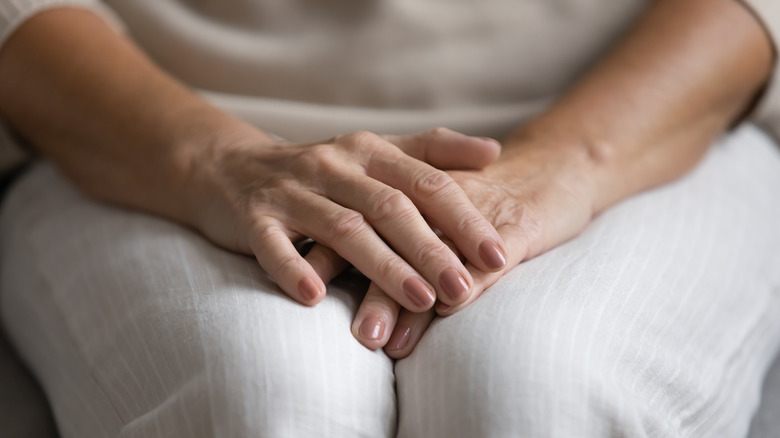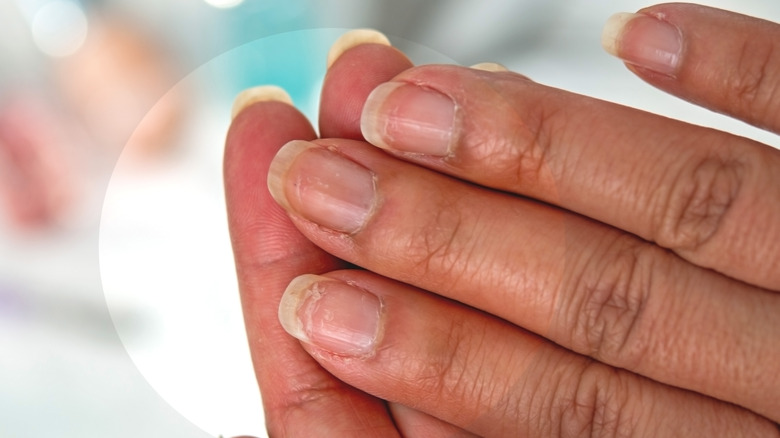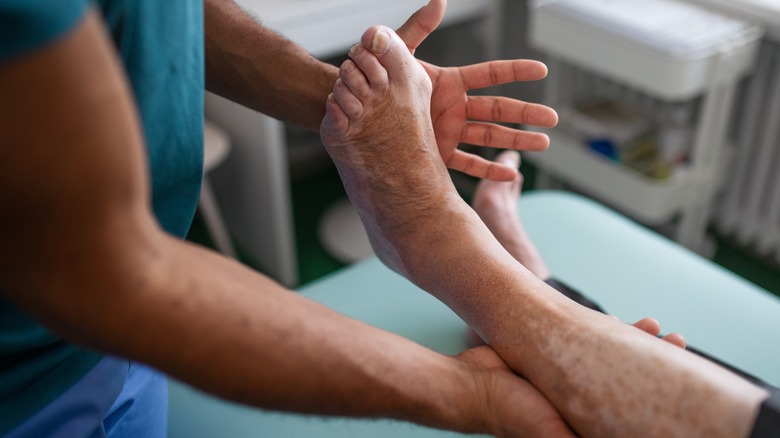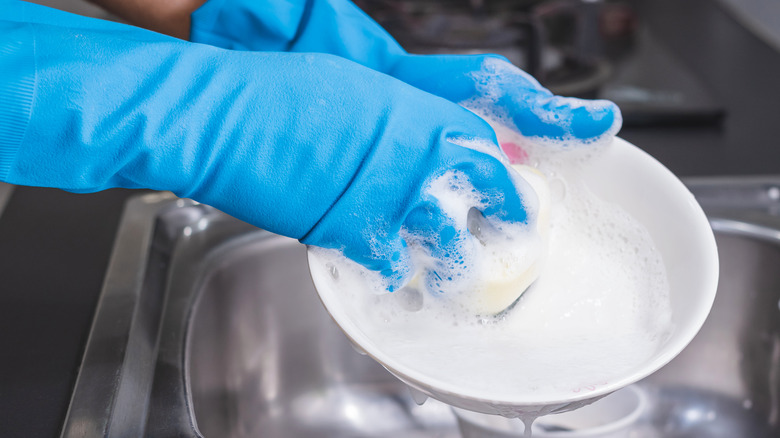What Happens To Our Nails As We Age?
Our nails are constantly undergoing a cycle of renewal. They begin as live cells in the matrix of the nail — the pouch of skin behind our cuticles that receives nutrients from our red blood cells (via Livescience). From there, these cells are shoved out of their cozy little home beneath our skin and progressively nudged forward as new cells are continuously formed at the root. As they grow, these keratin cells solidify into the hard covering that is our nail plate.
Amanda Meyer, a lecturer in human anatomy at the University of Western Australia, tells Live Science how this rate of growth differs between our fingernails and toenails. "Continuous division of matrix cells pushes the nail plate forward over the nail bed at a rate of about 3 millimeters [0.1 inches] per month for fingernails, and 1 millimeter [0.04 inches] per month for toenails," Meyer tells the publication.
So if our nails are always in motion, what kinds of changes can we expect as our nails age along with us over time?
Shifts in nail color, shape, and strength
It doesn't take long for our nails to age. In fact, research published in Canadian Family Physician Médecin de Famille Canadien outlines that from as early as age 25, we begin to experience a slowdown in nail growth by an annual rate of 0.5%. Not only do we experience changes in speed of growth, but our nails also become prone to changes in color, shape, and strength.
Research shows that elderly individuals often experience a yellowing or graying of the nail plate that looks cloudy or dull in appearance (via Canadian Family Physician). In addition, one might also observe changes in the curvature of the nail over time as well. Alternatively, many experience changes in nail thickness as they age. For some, their nails may become thicker, while others may notice nail thinning. Because the development of brittle nails is amongst one of the more common nail-related disorders experienced by older adults, this can make nails more prone to breakage.
There are many contributing factors as to what causes these age-related nail changes in adults. Such potential factors include decreased circulation in the fingers and toes, as well as changes in weight, posture, or gait, according to Nails.
Age-related nail conditions
Our nails also become more susceptible to changes in texture as we grow older. "When parts of the nail growth plate (aka the nail matrix) become thinner and begin to atrophy, the result is ridging (parallel longitudinal depressions in the nail plate)," Dr. Dana Stern, assistant clinical professor of dermatology at Mount Sinai Hospital, tells HuffPost. In addition to the development of ridges, you may also notice partial separation of the nail plate from the nail bed. Dr. Stern explains that as we age, it doesn't take much to prompt this separation — otherwise known as onycholysis — which is why you don't want to be too heavy-handed when cleaning your nails as you age.
As well as being careful while grooming, you'll also want to try and avoid any potential stubbing of the fingers or toes. Because our nails are more susceptible to subungual hemorrhages as we age, a nail injury could cause blue discoloration in the nail due to pooled blood beneath the surface (via Nails). Older adults who utilize blood thinners are particularly prone to this occurrence.
How to preserve youthful nails
While aging is inevitable, experts say there are things we can do to preserve the health of our nails as we grow older. Dr. Stern tells HuffPost that keeping clean and hydrated cuticles is key — such as through the use of daily moisturizing oils or ointments, rather than heavy creams. For those who enjoy painting their nails, opt for products that are void of acetone, which can zap our nails of moisture and leave them weak.
On the flip side, however, beware of too much water. "Nails are extremely absorptive of water (even more so than skin) ― when water is constantly moving in and out of the nail it puts a tremendous strain on the delicate nail cells, which can result in weakening, softening, and breakage," says Dr. Stern via HuffPost. Therefore, popping on a pair of gloves when hand-washing clothes or scrubbing down the car can help keep your nails dry and protected.
Lastly, it's important to be mindful of the tools we're using to groom our nails. According to Nails, we don't want to be using the same nail clipper for years on end. Therefore, it's important to swap out your old clipper for a fresh one every so often once the blades become worn. For those in need of nail-clipping assistance as they age, be sure to consult your podiatrist for routine maintenance.




